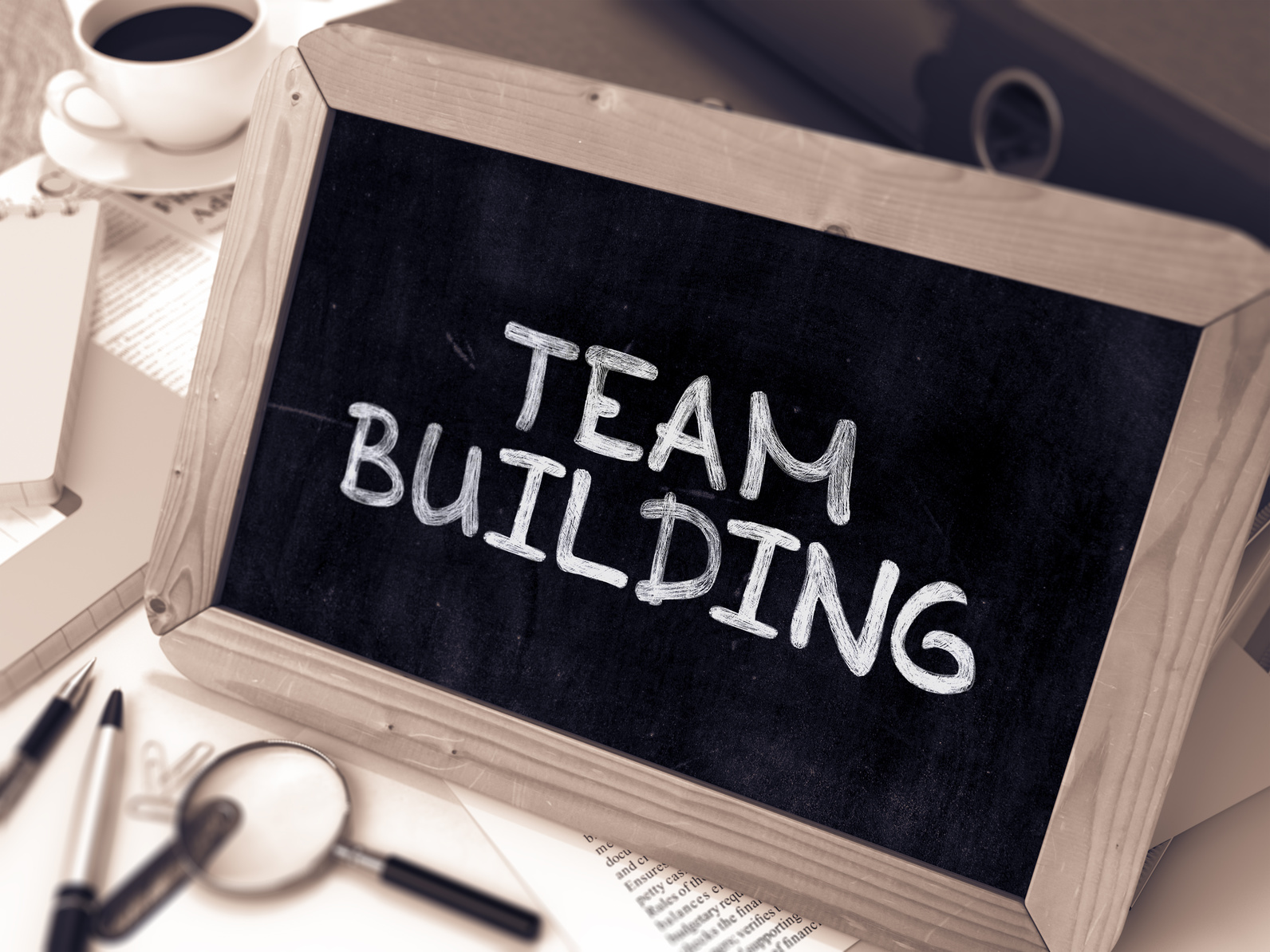If you think team building is just a corporate icebreaker, think again. Nearly 75% of employers say teamwork and collaboration are vital.
However, only 18% of staff are evaluated on communication during reviews. This gap highlights a big chance to better team building in companies.
As a Team Building Facilitator on workplace culture, I’ve seen how team building case studies can change how a team works.
Indeed, stories of team building success often begin by highlighting the need for trust and good communication. This is especially true when teams shift from working remotely to being in the office.
But what about real outcomes? Are these efforts making a real difference? That’s what results from team building activities want to show us.
By looking at real examples, their wins, and the planning behind them, companies can use these powerful approaches. They can improve how their teams talk, work together, and get things done.

holiday-team-building-activities
Key Takeaways
- The importance of team building is underscored by the gap between employer expectations and employee evaluations.
- In-depth team building case studies demonstrate the transformative potential of well-engineered team building activities.
- Corporate team building success stories often emphasize the role of trust and truthful communication in a cohesive workplace culture.
- Quantifying team building activities results is crucial for understanding their true impact on an organization’s performance.
- Strategic insights from case studies can guide companies in creating more effective team building experiences.
- Focusing on these insights helps businesses transition smoothly from virtual to physical workspaces while maintaining team integrity.
The Link Between Truth-Telling and Trust in Team Building
Teams today often switch between meeting in person and working online. This makes a trustworthy atmosphere more important than ever. Gossip and backbiting can hurt team performance.
This is especially true after working from home. Understanding how truth-telling and trust work together is key for team success.
The Problem: Gossip and Backbiting in Post-Remote Work Environments
Returning to shared workspaces can bring back workplace negativity, like gossip. In these times, clear communication is crucial. Gossip can damage the process of building a strong team.
The Trust Model: A Foundation for Effective Team Building
On the other hand, truth-telling is vital for building a good team. Leaders who are open and honest create a culture of trust. This trust is crucial for the team to work well together.
Companies that embrace honesty see great teamwork and success.
Truth-telling in the workplace is not just a moral imperative but a strategic one that has a profound effect on team alignment and overall business health. – Based on corporate leadership observations
The table below shows how trust can make teams work better:
| Trust Factor | Impact on Team Building | Implementation Strategy |
|---|---|---|
| Transparent Communication | Reduces misunderstandings, focuses on clear and open dialogue | Regular team meetings with agenda-free discussions |
| Accountability | Creates a sense of responsibility amongst team members | Setting specific, measurable objectives for individual and team performance |
| Shared Goals | Encourages collaboration towards a common purpose | Co-creation of team targets and recognition of milestones |
Embracing the values of the trust model can change workplace culture. This shift is crucial for the long-term success of any team.
Exploring Self-Awareness in Leadership Development Programs
As I explore self-awareness in leadership development programs, I see its huge impact. It’s more than just looking inward; it opens the door to better team interactions.
In essence, it strengthens team building case studies for companies. It’s amazing to see how personal insight and team work together, boosting performance.
>>>>Click here for fun team building games to boost morale.
Leaders who focus on self-awareness make their teams stronger and more united. They handle tough situations better, thanks to empathy and smart planning.
I have found evidence showing the big difference self-aware leaders make. Here’s a brief overview:
| Leadership Quality | Impact on Team Dynamics | Overall Performance |
|---|---|---|
| High Self-Awareness | Increased trust, openness, and collaboration | Enhanced problem-solving, productivity, and adaptability |
| Low Self-Awareness | Conflicts, ambiguity in roles, and misaligned expectations | Decrement in morale, innovation, and efficacy |
Being self-aware is crucial not just for personal growth. It helps leaders create a positive team environment. This makes team members feel important and understood.
In studying leadership development programs, I stress this point: teaching leaders to know themselves benefits the whole organization. It leads to big achievements and success stories.
Assessing Team Building Outcomes with Case Studies for Companies
In my study of team building’s impact, I looked at different kinds. I found many cases showing team building’s big benefits for even large groups. These examples highlight how well-planned team activities can boost teamwork and spark innovation.
Teaming Strategies in Large Corporations
Big companies like Google and Amazon have shared their experiences. They’ve used team building to improve their complex systems. They aim to overcome department barriers and increase communication across different teams.
Their efforts enhanced teamwork and raised productivity. This gave them an edge in their markets.
Case Studies: Family Firms and Start-Up Dynamics
Family businesses and startups may be smaller but face big challenges. Studies on team building in these setups show it’s very useful. They use specific team activities to connect generations and unite everyone’s goals.
This leads to a smoother and more flexible way of working.
These examples prove investing in team building is essential. It drives long-term success and keeps employees committed.
Dissecting the Five Stages of Team Development
Exploring team evolution reveals the value of the five-stage model. It guides a group from individuals to a united force. This journey is key to facing corporate challenges together.
Case Study: The Storming Phase in Action
The storming phase is crucial in team development. Facing conflicts here promotes open communication. It helps in crafting team building success stories by aligning individual strengths towards a common goal.
Success Stories and Pitfalls
After storming, successful teams reach the norming stage. They set rules and move smoothly into performing. Here, effective team building activities highlight their worth in achieving project success.
| Stage of Development | Characteristics | Activities & Outcomes |
|---|---|---|
| Forming | Members are polite and positive, but uncertain. | Icebreakers and introductions to build rapport. |
| Storming | Tensions emerge; individuals express concerns. | Conflict resolution exercises to define team norms. |
| Norming | Team establishes rules and values for collaboration. | Development of a collective mission or project charter. |
| Performing | The team works effectively toward common goals. | Strategic planning sessions to optimize performance. |
| Adjourning | Reflection on achievements and learnings. | Celebrations and retrospectives to capture success. |
Team building success stories always highlight the structured development’s importance. They offer valuable lessons to organizations. These insights help build teams that exceed business goals.
Addressing Inter-Team Conflict with Proven Team Building Activities
In my search to solve inter-team conflict, I’ve learned something important. Team building activities are key to keeping teams together. Such activities help set the right standards and improve how we talk within the group.
The Importance of Normative Behavior for Team Cohesion
Following set behaviors is crucial for a good team vibe. For instance, in our team-building efforts, we emphasize behaviors that match our company values. This guides everyone towards working better together, reducing tension.
Insights into Communication Styles and Conflict Resolution
Team-building exercises are great for checking out different ways to talk to each other. They teach us to chat better and fix disagreements in a peaceful way. It’s the small changes in how we communicate that help a team go from okay to great.
- Workshop on Active Listening – Helps us grasp the value of listening well in a team.
- Role-playing Scenarios – Lets members try out fixing conflicts in a safe space.
- Feedback Circles – Makes us more open and honest in sharing thoughts, improving how we solve problems together.
Let’s look at two examples where these approaches made a big difference:
| Scenario | Issue Addressed | Action Taken | Outcome |
|---|---|---|---|
| Communication Workshop | Misunderstandings impeding project advancement | Implemented an active listening workshop | Improved team rapport and project delivery times |
| Conflict Management Training | Frequent disagreements within the team | Conducted role-playing exercises for conflict resolution | Decreased conflicts and expedited decision-making |
The workshops and training discussed show how carefully chosen team building can build trust and efficiency. It’s all about picking the right activities to match the team’s needs.
The Role of Transformation in Team Building
Transformation in teams is vital for organizations to succeed in changing markets. My research highlights the crucial role of team building impact analysis in understanding transformation.
It shows how teams can reach their full potential through team building activities results.
Teams that partake in structured team building become more adaptable and resilient. This adaptability is essential in today’s fast-paced work environment.
Adapting to Rapid Change: A Case Study
A tech firm once faced a huge industry shift. By analyzing team building impact, they pinpointed innovation blocks. Strategic team building activities then led to major improvements.
These actions revolutionized the company’s adaptability. It showed how transformation and team dynamics are key for survival and growth.
Surviving and Thriving through Team Transformation
Survival alone isn’t enough for teams. They must also flourish in times of change. Teams need to transform, becoming stronger and more united.
This change isn’t solely for survival. It’s for gaining a competitive advantage. Team building activities are crucial in this transformation journey.
| Pre-Transformation Attributes | Post-Transformation Outcomes |
|---|---|
| Rigid Hierarchical Structures | Flexible Team Configurations |
| Top-Down Communication | Open and Collaborative Discourse |
| Aversion to Risk | Calculated Risk-Taking |
| Limited Employee Autonomy | Empowered Decision-Makers |
| Fixed Skill Sets | Continuous Learning and Development |
>Click here for fun team building games to boost morale.
In summary, combining team building analysis with real transformation stories shows the importance of adaptability.
The tech firm’s story proves that welcoming change leads to organizational success. Right team building activities turn challenges into opportunities for growth.
Creating Effective Team Building Experiences Across Global Corporations
I work to improve team dynamics in global companies. I’ve learned that cultural differences matter in team building. It’s tough to bring teams together from different parts of the world. They must understand how culture affects communication and teamwork.
Cultural Considerations in Team Dynamics
I’ve looked at many team building cases. It’s clear we must consider each team’s culture. This means more than just language. We must respect social norms and business practices that vary globally. This respect is key to inclusivity and success.
Global Team Building Success: Diverse Approaches and Outcomes
Looking at case studies shows no single way to build a team. Tailoring activities to the team’s diverse needs boosts creativity and team spirit. Mixing social events with business tasks helps create strong bonds.
The key to global team building is valuing each person’s unique input. Building activities that embrace diversity drives innovation. It helps companies stay ahead in the world.
Tailored Team Building for Specific Challenges and Opportunities
Identifying a company’s unique needs and crafting special team building plans is key. It’s amazing how focusing on specific challenges changes team dynamics. This leads to great project results.
Case Example: Overcoming Interdepartmental Silos
Looking at case studies of companies overcoming interdepartmental barriers is enlightening. One effective approach involved cross-training sessions.
These sessions let employees learn about their colleagues’ roles in other departments.
Understanding each other’s work brought employees closer. It created a feeling of unity and shared goals.
Strategies for High-Stakes Project Teams
High-stakes projects need exactness, hard work, and everyone working smoothly together. Including team building activities throughout the project helps improve efficiency. Meeting tight deadlines becomes easier without sacrificing quality.
For example, team retreats with workshops on communication and stress relief boost team performance under stress. I’ve seen these retreats make a big difference in how a team handles pressure.
| Challenge | Strategy | Outcome |
|---|---|---|
| Interdepartmental Silos | Cross-Training Sessions | Enhanced Interdepartmental Communication and Collaboration |
| High-Stakes Projects | Targeted Retreats and Workshops | Improved Performance and Stress Management |
In my work with various industries, I’ve seen first-hand how these approaches bring strong benefits. Proactively using these strategies significantly boosts team dynamics and project success.
Truly, grasping the unique challenges of a team is crucial for effective team building.
Benefits of Team Building in Organizations Based on Research
My research into team building shows it’s very valuable for companies. These activities boost teamwork and make the workplace better.
Wondering if these efforts matter? Many studies show they do. They lead to:
- Improved Communication: Post-team building, employees often report clearer and more open lines of dialogue with their peers.
- Enhanced Productivity: A strong team is like a well-oiled machine—coordinated efforts often result in greater output and efficiency.
- Better Employee Morale: When staff feel connected and valued, their satisfaction and enthusiasm for work soar.
Team building starts a cycle of improvements. Better morale boosts productivity. In turn, this improves how teams communicate. It’s a cycle that starts with team building.
Team building isn’t just for the moment. It brings long-term changes to a company’s culture. Leaders say it’s key for success.
Here are some stats to show it. I’ve looked at studies to see the real effects of team building.
| Aspect | Before Team Building | After Team Building |
|---|---|---|
| Communication Quality | Moderate/Inconsistent | High/Consistent |
| Productivity Index | Average | Increased by 20% |
| Employee Satisfaction | Low | High |
All the evidence shows team building works. It leads to a stronger, more innovative workplace. This sets a company up for success.
Team Building Case Studies
In the world of corporate growth, I’ve seen a key fact. The real proof of successful team building is in the details of team building activities results. Studying team building impact analysis teaches us a lot.
It’s not just about reaching a goal but how the team changes along the way.
At first glance, team building’s effects may seem hard to measure. But, looking closer at case studies shows us numbers and facts.
A comparative table below shows how different team building activities have helped organizations. It links the activities directly with their results.
| Activity | Objective | Immediate Impact | Long-Term Benefits |
|---|---|---|---|
| Cross-Functional Collaboration Workshop | Break down silos between departments | Enhanced interdepartmental communication | Sustained increases in project efficiency |
| Outdoor Team Challenges | Boost team morale and solidarity | Improved relationships and camaraderie | Decreased employee turnover |
| Problem-Solving Escape Rooms | Enhance critical thinking and collaboration | Sharpened problem-solving skills | More innovative approaches to challenges |
| Leadership and Trust Retreats | Strengthen trust and leadership skills | Increased trust in leadership | More engaged and empowered teams |
The difference between short-term effects and long-term gains shows why team building impact analysis is vital. It ensures that team unity lasts long in a company’s culture.
I’ve seen how well-planned team building can change the work environment. It transforms competitive individuals into team players who trust and depend on each other.
When we talk about team building activities results, let’s think about not just now but the future.
After all, isn’t that the goal of a great team effort?

Verbal communication
>>>>Click here for fun team building games to boost morale.
Leveraging Insights Tool for Enhanced Team Effectiveness
In my work with team building, the Insights tool has been a game-changer. It helps uncover what teams like and the challenges they face.
What’s great about the Insights tool is its ability to show teams how they work together. This helps them make better decisions for success.
Case Study: Discovering Team Preferences and Blockers
A tech company had trouble with its developers and sales teams communicating. They used the Insights tool and saw they had different ways of talking.
The sales people were fast-paced, while the developers were more detailed. Knowing this, the company started workshops to help both teams understand each other better.
Improving Performance Through Team Preferences Alignment
Another story is about a consumer goods company facing low morale. The Insights tool showed a big difference between what the team liked and the company’s culture.
The leaders changed the workspaces and schedules to match the team’s preferences better. This made employees happier and more likely to stay.
After making changes from what they learned from the Insights tool, the consumer goods company saw a 25% increase in how well the teams did and fewer employees left.
This shows how important it is to match work with personal preferences for success.
These examples show how useful tools like Insights are in solving team issues. By really understanding what each team needs, companies can overcome problems. This leads to better results for teams in all kinds of work.
Innovative Team Building Activities That Work
In my experience, innovative team building exercises improve team connections. They add a fresh twist to usual activities.
For example, The Chocolate Challenge uses hands-on tasks to boost teamwork and think ahead. MBTI tools help with self-knowledge and valuing team variety.
Hands-On Learning: The Chocolate Challenge
The Chocolate Challenge is a great team-building activity. Teams make chocolate products together. This boosts engagement and promotes teamwork and learning.
It lets participants connect in meaningful ways. Here’s what The Chocolate Challenge does for teams:
| Activity Aspect | Skills Enhanced |
|---|---|
| Creative Design | Innovation, Artistic Collaboration |
| Time Management | Efficiency, Prioritization, Strategic Planning |
| Role Allocation | Leadership, Responsibility Sharing, Resource Allocation |
| Product Marketing | Communication, Sales Strategy, Branding |
Unlocking Creativity with Myers-Briggs Type Indicator Programs
MBTI workshops are great for team building. They help teams understand their personality types. This boosts creativity and team work.
MBTI makes teams more cohesive by:
- Improving communication and reducing conflicts through understanding differences.
- Encouraging innovative problem-solving by valuing unique perspectives.
- Focusing on personal development to increase team performance and happiness.
Activities like The Chocolate Challenge and MBTI workshops mix fun, creativity, and growth.
They’re not just original. They blend play with purpose. This helps teams become strong and ready to face any challenge together.
Got Team Building Games? – PRESS PLAY #funatwork #gameshows #boostmorale
![]()
Book a live game show experience today!
Contact us for further details.
For Immediate assistance by text – 917-670-4689
No deposit required.
We plan and facilitate all activities
Overcoming Challenges with Tailored Team Building Solutions
Looking closely at team dynamics shows that general solutions don’t always work. A deep insight into each company’s culture is essential.
By understanding what makes each team unique, we apply the most effective team building best practices. This is something many team building case studies have shown to be true.
When a team’s core values are part of their daily routine, they handle problems better. These challenges then help the team grow and innovate together. Team building isn’t just for solving issues. It’s about turning these issues into chances for improvement.
Take a global company dealing with communication problems due to cultural differences. Creating team building activities that value everyone’s background can improve work relationships. It makes cultural diversity a key benefit to the company.
In small businesses, personal conflicts can really hold back progress. Tailored team building that teaches conflict resolution and understanding makes teams stronger.
This way, they can be creative and solve not only current problems but also future ones. This strategy has been proven by many team building case studies.
But, it’s crucial to check if these strategies actually work. We look at feedback, performance data, and team behavior before and after team building. This ensures lasting improvements in teamwork and strength.
In summary, addressing team challenges with specific solutions proves most effective. Giving teams the right tools for their unique needs improves their work and motivation. When done right, the impact on performance and team spirit is incredible.
Measuring Impact and Success of Team Building Interventions
Exploring the real impact of team building in companies is fascinating. We see clear benefits from these efforts. These benefits range from better performance to improved team dynamics.
>>>>Click here for fun team building games to boost morale.
Quantitative Analysis: Performance Metrics Post Team Building
Quantitative metrics help us see if team building works. We use numbers to look at the positive changes team building makes. By checking performance before and after, we learn about the benefits of these activities.
| Performance Metric | Pre-Team Building | Post-Team Building | Percentage Change |
|---|---|---|---|
| Productivity Rate | 75% | 85% | +13% |
| Employee Turnover | 20% | 15% | -25% |
| Project Completion Time | 8 Weeks | 6 Weeks | -25% |
| Customer Satisfaction Score | 80% | 90% | +12.5% |
Qualitative Feedback: Employee Engagement and Morale
Measuring success goes beyond numbers. We also focus on feelings and social changes from team building. Personal stories and surveys show us the unseen advantages.
They tell us about better teamwork, more joy at work, and a more positive culture.
- Increases in reported job satisfaction
- Testimonials about improved workplace relationships
- Growth in employee engagement levels
- Expressions of a stronger alignment with company values
To wrap up, looking at both data and stories is key. This way, we see all the benefits of team building. It proves team building is crucial for strong, healthy companies.
Team Building Best Practices from Real-World Applications
I’ve learned a lot about team building by looking at the real world. Transparent communication is key, I found. It strengthens trust and keeps away misunderstandings that could lead to conflict.
Teams work better when everyone feels they are listened to and understood.
In my journey, I saw how important including everyone in decisions is. It brings out creative ideas and strong strategies.
This not only strengthens the team but also improves how well they perform. When each person can share their thoughts and feels valued, the team’s output is amazing.
Support in a team means more than just encouragement. It involves helpful feedback, resources for growth, and celebrating achievements.
Teams that get this kind of support work better together. They have strong connections, high morale, and a united front. These practices aren’t just advice; they’re clear steps towards building a successful, collaborative team.
FAQ – Team Building Case Studies
What are some effective team building case studies?
Companies big and small have benefited from team building. These activities focus on improving communication, trust, and working together.
For instance, tech companies might mix workers from different departments for projects.
Startups may have retreats to unify their teams and set common goals.
How does truth-telling contribute to trust in team building?
Being honest is key in teams. It makes a team’s culture strong and trustworthy. Leaders play a big role by encouraging open talks.
This reduces gossip and helps teams in any work setting.
How is self-awareness integrated into leadership development programs?
Self-awareness is vital in leadership programs. It makes leaders mindful of their impact on the team. Through tools, feedback, and coaching, leaders learn to better the group’s unity and results.
Can you give an example of how large corporations approach team building?
Big companies tackle team building amidst their vast and varied workforce. They use special programs to break down barriers and boost teamwork. Global firms might include training on cultural intelligence to aid diverse teams.
What does the storming phase of team development entail?
The storming phase comes second in developing a team. Members test their limits and roles here. It’s a time for setting how to communicate and solve conflicts in positive ways.
What team building activities can help resolve inter-team conflict?
Focus on activities that foster talking and solving problems together. Workshops on resolving conflicts, role-playing, and team assessments are good. They help see each other’s views and collaborate better.
How can teams adapt to rapid changes effectively?
Ready teams can quickly adjust to changes. A shared goal, good conflict skills, and adaptable rules are key. Training for change helps teams adjust swiftly.
How important are cultural considerations in global team building?
They’re crucial. Cultural differences can confuse and slow down global teams. Building such teams needs an understanding of various cultures to include everyone and work well together.
What specific challenges can tailored team building address?
Custom team building can solve particular problems. It can improve talk between sections, help people collaborate on big projects, or welcome new folks from various cultures. Right activities make a difference.
What are some benefits of team building in organizations?
Studies confirm team building boosts communication, productivity, and morale. It also strengthens bonds, sparks creativity, and helps in solving problems.
How can the Insights tool help improve team effectiveness?
The Insights tool gives a clear view of a team’s preferences and challenges. Knowing this, teams can play to their strengths. This leads to better results and teamwork.
What are some innovative team building activities that have proven successful?
Some fun activities include The Chocolate Challenge for strategy and teamwork. Programs like Myers-Briggs help understand different personalities. These activities are engaging and promote unity.
How do organizations measure the impact of team building interventions?
Results are seen in improved numbers, like better performance and productivity. Feedback and how happy employees feel also show success. Keeping track of these can highlight a program’s value.
What best practices have emerged from real-world team building applications?
Best practices involve open communication, celebrating shared achievements, valuing different ideas, and matching activities with the group’s main values. These help build a lasting spirit of teamwork.









